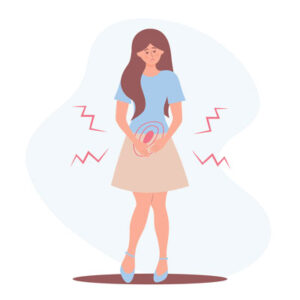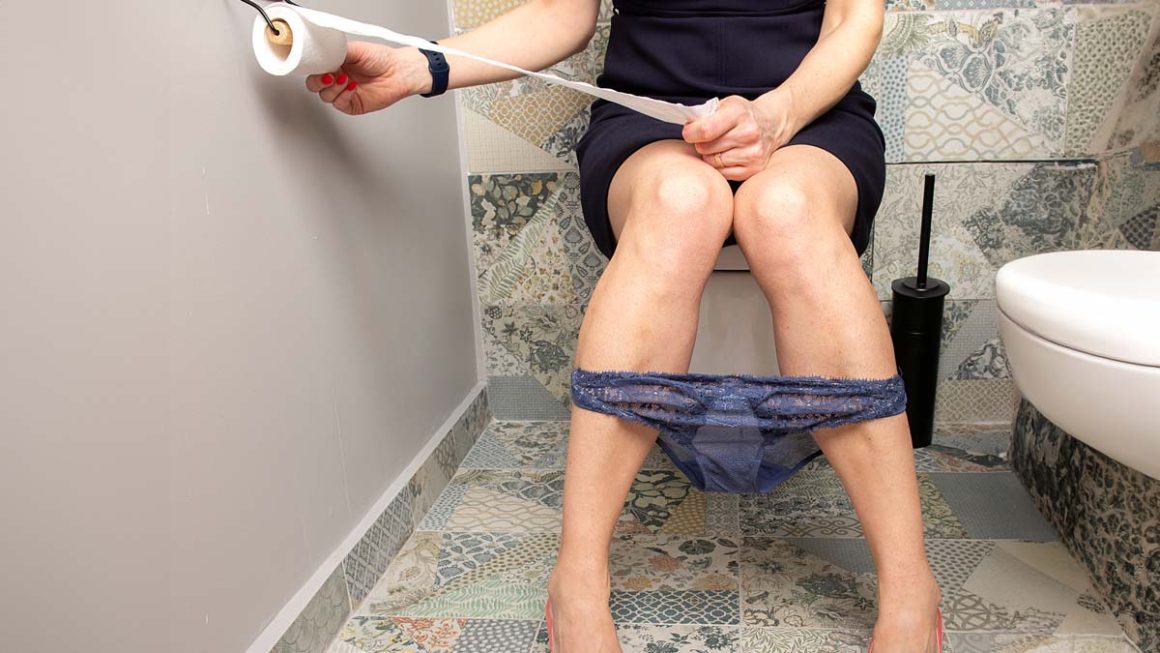Urinary incontinence is the loss of the ability of the bladder to hold urine for various reasons and consequently involuntary leakage of urine. Urinary incontinence may develop temporarily due to pregnancy; urinary tract infections; some medications such as heart, blood pressure, muscle relaxants; consumption of products such as alcohol, caffeine, carbonated drinks, hot spices. Permanent urinary incontinence can be seen due to aging, menopause, assisted delivery, multiple number of pregnancies and vaginal births, obesity, constant straining and chronic coughing, conditions that increase the intra-abdominal pressure and some neurological diseases.
The most common types of urinary incontinence can be analysed under three main categories:
 Involuntary urinary incontinence which occurs suddenly in situations that increase intra-abdominal pressure such as coughing, straining, sneezing is called ‘Stress Incontinence’. It is the most common type of urinary incontinence seen especially in older women. Stress incontinence is due to the damage of the pelvic floor muscles that support the urethra and of the muscles that control the release of urine (urinary sphincter) because of difficult vaginal births and age-related weakening.
Involuntary urinary incontinence which occurs suddenly in situations that increase intra-abdominal pressure such as coughing, straining, sneezing is called ‘Stress Incontinence’. It is the most common type of urinary incontinence seen especially in older women. Stress incontinence is due to the damage of the pelvic floor muscles that support the urethra and of the muscles that control the release of urine (urinary sphincter) because of difficult vaginal births and age-related weakening.
‘Urge Incontinence’ is leakage of urine following a sudden, intense feeling of squeezing. In this case, the bladder contracts against the will of the person and urinary incontinence occurs accordingly. With the sudden feeling of squeezing, the person leaks urine involuntarily before reaching the toilet.
The third type is ‘Mixed Type Incontinence’ in which stress and urge urinary incontinence are seen together.
 Urinary incontinence is definitely a condition that impairs the quality of life. Having to use pads constantly, odour and urinary incontinence in unexpected situations negatively affect women’s self-confidence and may even cause social isolation. It also negatively affects sexual life.
Urinary incontinence is definitely a condition that impairs the quality of life. Having to use pads constantly, odour and urinary incontinence in unexpected situations negatively affect women’s self-confidence and may even cause social isolation. It also negatively affects sexual life.
Urge incontinence is treated with lifestyle changes and medication.
In stress incontinence, which develops due to increased intra-abdominal pressure, treatment is possible with surgery.
What is stress incontinence?
Stress incontinence is a sudden involuntary leakage of urine in situations that exerts pressure on the bladder by coughing, laughing, straining, sneezing, lifting something heavy. These are all activities that increase the intra-abdominal pressure.
Why does stress incontinence develop?
Damage and weakening of the pelvic floor muscles causes stress incontinence. Damage due to difficult vaginal births and weakening of the muscles because of advanced age are the most common causes of stress incontinence.
Can stress incontinence be treated?
Stress incontinence is definitely treatable. Kegel exercises, lifestyle changes and surgery are the main treatment methods for stress incontinence.
Does stress incontinence require surgery?
The final treatment of stress incontinence is surgery.
What is the first treatment option for stress incontinence?
The first treatment option is determined according to the degree of incontinence and the level of the patient’s impact from this condition. While non-surgical options are preferred in mild cases, surgery is recommended in moderate and advanced cases.
Am I a suitable candidate for stress incontinence surgery?
If the existing urinary incontinence is at a level that impairs the quality of life and negatively affects the daily life of the woman, surgery is recommended. In very rare cases that do not significantly affect the quality of life, Kegel exercises and lifestyle changes are recommended.
What is the main goal of stress incontinence surgery?
Repairing the structures supporting the neck of the bladder and preventing this area from collapsing downwards during increased intra-abdominal pressure is the main goal of surgery for stress incontinence.
How is stress incontinence diagnosed?
Firstly, a detailed history is taken to determine the level of urinary incontinence problem affecting the person. During the gynaecological examination, weakness in the neck of the bladder is evaluated. It is observed whether urine escapes by coughing with a full bladder. If no definite conclusion can be reached with this evaluation, functional evaluation of the lower urinary tract is performed with the urodynamic tests.
What should I do before the operation?
Hair removal of the external genital area should be performed. Vaginal infection or the presence of abnormal vaginal discharge may cause the operation to be postponed.
Step by step operation process:
Anaesthesia: General anaesthesia is applied.
Surgical procedure: The most common surgical procedure is to insert a special supporting material into the mid-urethra (lower urethra). This operation is called ‘TOT application’ (midurethral sling operation). In experienced hands, it is a minimally invasive surgery that can be done in a short time, has a very low complication rate with a success rate of 90%.
What should I expect after stress incontinence surgery?
After the operation, the urinary catheter is kept for 24 hours. Serious bleeding, pain and swelling are usually not observed.
What should I pay attention to after stress incontinence surgery?
Wound care should be done as recommended by your doctor and medications should be used. Change pads frequently. Avoid heavy physical activities in the early postoperative period. Do not use tampons without your doctor’s permission. Sexual intercourse is not recommended for two months. Also, swimming, bathing in the tub and sauna should be avoided for two months.
How much rest is required after stress incontinence surgery?
Home rest is required for one week after stress incontinence surgery. Sexual intercourse, heavy lifting, heavy sports are not recommended for two months. However, this period may change if additional surgery is performed.
When can I return to work after stress incontinence surgery?
You can return to work one week after stress incontinence surgery. However, this period may change if additional surgery is performed.
What are the results of stress incontinence surgery?
Early complication rates of stress incontinence surgery are very low. The success rate of the surgery performed by experienced gynaecologists is around 90%.
Frequently Asked Questions
Urinary incontinence that develops under certain conditions and disappears with the improvement of this condition is called ‘temporary urinary incontinence’. This type of urinary incontinence can be seen during late pregnancy and urinary tract infections. However, when the pregnancy ends and the infection is treated, the urinary incontinence disappears.
Risk factors for stress incontinence include multiple number of pregnancies and vaginal births, traumatic vaginal deliveries, assisted deliveries, delivering a large baby, advanced age, connective tissue disorders, chronic lung diseases that cause continuous coughing, obesity, and jobs that require heavy lifting.
A person with stress incontinence notices that their underwear gets wet and they involuntarily leak urine when they cough, laugh, lift weights, sneeze. These are activities that put the bladder under sudden extra pressure
Practising Kegel exercises, making some lifestyle changes like reducing your intake of caffeine, altering the amount of fluid intake, losing weight if you are overweight or obese, and going to the toilet frequently can reduce the frequency of urinary incontinence
Healthy lifestyle recommendations for the treatment of urinary incontinence include limiting daily fluid intake; limiting tea, coffee and cola drinks; reducing consumption of bitter, sour and spicy foods; losing weight if you are overweight or obese; and avoiding heavy sports and jobs that require heavy lifting.
Stress incontinence can regress with non-surgical treatment approaches. Kegel exercises and appropriate lifestyle changes are treatments that the person can apply on his/her own.
The most successful and common stress incontinence surgery is mid-urethral sling operation (TOT) in which a special synthetic material is placed in the middle part of the lower urinary tractus for supporting the mid-urethra.
The success rate of stress incontinence surgery is up to 90% in experienced hands.
You can take a shower 48 hours after the operation.
Since stress incontinence surgery is performed vaginally, no scar is visible from the outside.
In stress incontinence surgery, stitches are not removed because self-absorbing suture material is placed in the vagina.


Leave a Reply
You must be logged in to post a comment.